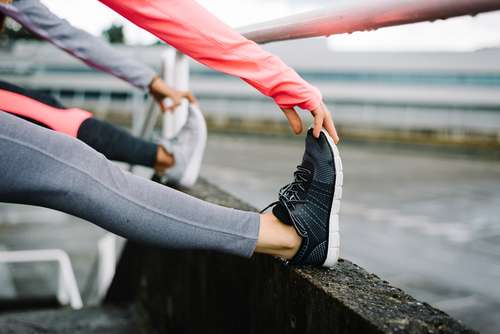Are you looking to start an exercise program to get back into shape and live a healthier lifestyle? An exercise routine may feel time consuming — but no matter what type of workout you choose, or how busy your schedule is, it’s critical that you don’t skip warming up before your workout, or cooling down afterwards.
You’d be surprised how many people decide they don’t need to warm up before working their core, or that it’s fine to skip their cool-down after jogging on the treadmill. In most cases, it’s not because people hate doing the warm up or cool-down, but because they want to save time. After all, it is just the main part of the workout that counts, right?
Unfortunately, it’s not just the main part of your workout that matters — and the people who skip the processes before and after a workout may be doing more harm to their bodies than they realize.
Why Warming Up and Cooling Down Is So Important
A warm-up and a cool-down both involve doing exercises at a lower intensity and slower pace, which improves your athletic performance, prevents injuries, and helps with recovery from exercise.
Warm up activities include light jogging, or cycling slowly on a bike. Warming up before exercise prepares your cardiovascular system for physical activity, by increasing the blood flow to your muscles, and raising the temperature of your body. It also helps to lower the risk of getting injured — when your muscles are adequately warmed up, the movements, stretches, and strain you put on them during your workout is less severe. This also minimizes muscle soreness.
Cooling down after your workout aims to gradually bring your heart rate and blood pressure to its normal level — the level it was at prior to exercising. During your workout, your heart rate has been pumping much higher than it does normally, and it’s important to ease it back down instead of abruptly stopping all motion. Cooling down also helps to regulate your blood flow, which is especially important for people who undertake endurance sports such as long distance running. To safely cool down, gradually reduce the pace of your exercise during the last 10 minutes of your session — for example, if you’re jogging, reduce your pace to a brisk walk for the last 10 minutes.
Benefits of Warming Up
- Improved Performance
Warming up improves your athletic performance in the following ways:
- Improved Blood Flow
— Warming up for 10 minutes with an easygoing activity improves blood flowing to your skeletal muscles, and opens up blood capillaries. Your blood carries the oxygen needed for your muscles to function, so increasing your blood flow is one of the best things you can do to set your muscles up for a workout.
- Improved Oxygen Efficiency
— When you do a warm-up exercise, oxygen is released from your blood more readily, and at higher temperatures. Your muscles demand higher amounts of oxygen while exercising, so it’s important to make this oxygen more available through a warm-up activity.
- Faster Muscle Contraction/Relaxation
— Warming up with physical activity raises your body temperature, which in turn, improves your nerve transmission and muscle metabolism. The end result? Your muscles will perform faster and more efficiently.
- Injury Prevention
Warming up prevents injuries by loosening your joints, and improving blood flow to your muscles — making your muscles less likely to rip, tear, or twist in a harmful way during your workout. Stretching also helps prepare your muscles for the physical activities you’re about to perform.
- Mental Preparation
A side benefit of warming up is that your brain will become focused on your body and your physical activity as you go through the process. This focus will carry over into your training session to help you to improve your technique, coordination, and skill.
Benefits of Cooling Down
- Recovery
After intense exercise, lactic acid builds up within your system, and it takes time for your body to clear it out. Cooling down exercises (such as stretches) can aid this process of releasing and removing lactic acid, helping to speed up your body’s recovery post-workout.
- Reducing DOMS (Delayed Onset Muscle Soreness)
While muscle soreness is to be expected after exercise, a significant amount of DOMS is very uncomfortable, and can prevent you from exercising in the future. A
study
performed by California State University found that moderate intensity cycling after strength exercise helped to reduce DOMS. Cooling down after exercise helps to alleviate excessive muscle soreness, keeping you more comfortable and allowing your body to bounce back before your next workout.
What Happens If You Don’t Properly Warm Up and Cool Down?
Increased Risk Of Injury
Over 30% of injuries seen by sports medicine clinics are skeletal muscle injuries — which can be easily prevented by warming up and stretching.
Blood Pooling
If you stop exercising abruptly without cooling down, your muscles will suddenly stop contracting vigorously. This can cause blood to pool in the lower extremities of your body, leaving your blood without as much pressure to be pumped back to the heart and brain. As a result, you may dizzy and lightheaded, and you may even faint.
Increased Stress On Cardiovascular System
Warming up helps you to gradually increase your heart rate and breathing to a level that will be able to meet the demands of your workout. If you start exercising at a strenuous level without warming up first, you will place unnecessary stress on your heart and lungs.
A study was performed on 44 men to examine the effects of high intensity exercise on the heart. The subjects had to perform 10 to 15 seconds of intense exercise on a treadmill, without a warm-up. The results showed that 70% of subjects had abnormal ECG readings because of the inadequate oxygen supplied to the heart — in essence, their hearts weren’t ready to perform at the high rates required for the intense exercises.
The next time you feel like you can’t spare the extra 10 minutes to cool down after running, think carefully about the effect it will have on your body. Those 10 minutes certainly seem worth it when you consider that you’re helping prevent injuries to your body, improve your performance, and aid your post-workout recovery.

“I don’t have time to cool-down” or “I’ll stretch later.” These common phrases are like nails on a chalk board to personal trainers and group fitness instructors around the country, yet are heard on a regular basis. With the perception of time being the most important determinant for an individual to remain diligent in their exercise routine, the cool-down is usually the first thing to go when time is of the essence. Although it may be easy to simply jump from the treadmill straight into the shower, or from the squat rack to the car, there are five very important reasons to think carefully before you pull the plug on your workout.
1. Blood Pooling
During exercise, the heart is pumping at an accelerated rate and the oxygenated blood has to be pumped from your heart and make it all the way through your lower extremities before working its way back to the heart (against gravity) to be re-oxygenated again. When the body goes from moving quickly or performing a lot of work during your last set to working less and moving slowly, the squeezing action provided by the working muscles is greatly diminished. When exercise is stopped abruptly, this can cause the blood to pool in the lower extremities and slow its return back to the heart and, subsequently, the brain. Another factor that adds to this dilemma is the one-way valves that are present within our vascular system. Veins, which are generally responsible for returning deoxygenated blood back to the heart and lungs, come equipped with one-way valves spaced throughout to prevent back flow. When the movement of blood slows within the vascular system, there is less pressure available to move the blood through these doorways, which causes the blood to become somewhat ‘trapped’ between these valves. All of this can lead to lightheadedness, dizziness and fainting. In fact, many fitness facility accidents occur in the locker rooms because of this blood pooling effect (especially with the elderly or those prone to cardiovascular issues). So, when you feel like jumping from your last sprint straight back into your street clothes, remember to take an extra few minutes to slow your roll, make sure your heart rate comes down slowly, and allow your body to become accustomed to the now diminished level of work. It might save you a trip to the emergency room.
2. Delayed Onset Muscle Soreness (DOMS)
DOMS occurs 24 to 48 hours after exercise due to microtears in the muscle fibers. This is a normal part of exercise and some soreness is to be expected, especially with resistance training or a new form of exercise. However, considerable amounts of DOMS is not comfortable and can be rather debilitating when trying to stay on a consistent exercise schedule. DOMS that hangs around for more than two to three days may also be a sign of overtraining or illness, or be a precursor to injury. Cooling down after your workout is a great way to help minimize the DOMS effect. A recent study conducted at California State University looked at the effect of recovery interventions of moderate- and low-intensity cycling, as well as seated rest after strength training. What they found was that when completed after the strength training bout, the moderate-intensity cycling cool-down showed a significant decrease in DOMS due to increased blood flow to the exercised muscles. So when your last reps are in the books, don’t forget to put your weights away and take a short spin on the closest bike; your quads will thank you in 24 to 48 hours.
3. Stress Relief
Exercise is a great way to step away from the day’s stresses and take care of yourself. Not only are you taking care of your body when you exercise, but you’re also taking care of your mind by helping to release the “feel good” hormones dopamine and serotonin, also known as endorphins. The cool-down is an important part of this process—when exercise is slowed and the body is allowed to gradually come back to a resting, balanced state (homeostasis), you will be able to take full advantage of the relaxed and euphoric effect that these neurochemicals have on your body. Taking a few moments to stretch, breath and reflect on your awesome workout will not only help you be on point when you enter back into your busy life, it will also leave you feeling refreshed and possibly ward off future diseases.
4. Injury Prevention
When you are finished with all your sets and reps or your final interval, your muscles are very warm and pliable (think of silly putty that you’ve been played with for a while), making static stretching a great addition to the cool-down to improve overall flexibility. When the muscles are stretched on a consistent basis, they become lengthened and, over time, will allow you to have more range of motion, warding off injuries that tend to plague the inflexible. This is also true for those who may not be of the competitive nature. Lower-back injuries are among the most common reasons for days missed at work and can be caused from tight hamstrings and/or tight hip flexors, which is why it is so important to give these areas some love after your workout. Two sets of 30-second static stretches will not only make your legs and back feel great, but you will also be more likely to catch yourself in a slippery situation and prevent a future injury.
5. Recovery
After an intense bout of exercise there is accumulation of lactic acid within the system. It takes time for this byproduct of exercise to be ‘buffered’ out, so 10 minutes of light exercise along with stretching is a great way to begin clearing the lactic acid from the body. It also helps to ensure that your body will be ready for its next physical test.
With all this talk about a cool-down it is important to know what to include during this essential part of your workout routine. A cool-down should fill the last five to 15 minutes of your workout, and include static (held for 30 seconds or so) stretches of the muscle groups you just worked. For example, if you did squats and push-ups, you’ll want to stretch your glutes, quads, chest and triceps. You should also include a light form of cardiovascular exercise. If you just finished a spin class or a run, try walking for five to 10 minutes and then do your stretches. Your cool-down might also include the use of a foam roller to help alleviate those tender points along the muscles. So, while it might be just as easy to skip out early, remember that a 10-minute cool-down can be the difference between you and your fitness goals.



